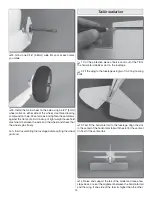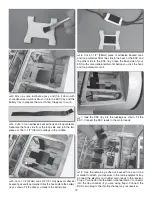
4
Required Adhesives
and Building Supplies
To finish this airplane you will need the following items.
❏
1 oz. [30g] Thin Pro
™
CA (GPMR6002)
❏
1 oz. [30g] Medium Pro CA+ (GPMR6008)
❏
2 oz. [60g] Foam Safe CA Activator (GPMR6035)
❏
Pro 6-minute epoxy (GPMR6045)
❏
R/C-56 canopy glue 4oz (JOZR5007)
❏
#11 Hobby knife w/ 5 blades (EXLR9018)
❏
3/32" Long Ball-Driver (GPMR8002)
❏
Drill bits: 1/16" [1.6mm], 5/64" [2mm], 3/32" [2.4mm]
❏
Builder’s Triangle Set (HCAR0480)
❏
18" flexible steel rule (HCAR0460)
❏
Hobbico Heavy Duty Diagonal Cutter 7" (HCAR0627)
❏
Pliers with wire cutter (HCAR0625)
❏
Panel Line Pen (TOPQ2510)
❏
Medium T-pins (100, HCAR5150)
❏
Epoxy brushes (6, GPMR8060)
❏
Mixing sticks (50, GPMR8055)
❏
Mixing cups (GPMR8056)
❏
Threadlocker
™
thread locking cement (GPMR6060)
❏
Denatured alcohol (for epoxy clean up)
❏
Light machine oil
❏
Flat metal file
❏
Masking tape
Optional Supplies and Tools
❏
Pro 30-minute epoxy (GPMR6047)
❏
3/8" [9.5mm] heat-shrink tubing (DUBM2180)
❏
21st Century
®
sealing iron (COVR2700)
❏
21st Century iron cover (COVR2702)
❏
Rotary tool such as Dremel
®
❏
Rotary tool reinforced cut-off wheel (GPMR8200)
❏
CA applicator tips (HCAR3780)
❏
CA debonder (GPMR6039)
❏
Dremel Drum Sander, Coarse 3/8” (DRER0968)
❏
Great Planes Easy-Touch
™
Hand Sander 5.5”
(GPMR6169)
❏
Great Planes Easy-Touch Sandpaper 150 Grit
(GPMR6183)
❏
Great Planes 1/5th Scale Sport Pilot – Red
(GPMQ9015)
❏
Great Planes 1/5th Scale Sport Pilot – Blue
(GPMQ9016)
❏
Great Planes 1/5th Scale Sport Pilot – Yellow
(GPMQ9017)
❏
Revell
®
Razor Saw (RMXR6960)
IMPORTANT BUILDING NOTES
•
There are three types of screws used in this kit:
Sheet metal screws are designated by
a number and a length. For example,
#6 x 3/4" [19mm]
Machine screws are designated by a
number, threads per inch, and a length.
For example 4-40 x 3/4" [19mm]
Socket Head Cap Screws (SHCS) are
designated by a number, threads per
inch, and a length. For example 4-40 x
3/4" [19mm]
• When you see the term
test fit
in the instructions, it means
that you should first position the part on the assembly
without using any glue
, and then slightly modify or
custom
fit
the part as necessary for the best fit.
•
Whenever the term
glue
is written you should rely upon
your experience to decide what type of glue to use. When
a specific type of adhesive works best for that step, the
instructions will make a recommendation.
•
Whenever just
epoxy
is specified you may use
either
30-minute (or 45-minute) epoxy
or
6-minute epoxy. When
30-minute epoxy is specified it is
highly
recommended that
you use only 30-minute (or 45-minute) epoxy, because you
will need the working time and/or the additional strength.
•
Photos
and
sketches
are placed
before
the step they
refer to. Frequently you can study photos in following steps
to get another view of the same parts.
•
The Mister Mulligan EP is factory-covered with Jet White
Top Flite
®
MonoKote
®
film (TOPQ0204). Should repairs
ever be required, MonoKote can be patched with additional
MonoKote purchased separately. MonoKote is packaged in
six-foot rolls, but some hobby shops also sell it by the foot. If
only a small piece of MonoKote is needed for a minor patch,
perhaps a fellow modeler would give you some. MonoKote
is applied with a model airplane covering iron, but in an
emergency a regular iron could be used. A roll of MonoKote
includes full instructions for application.





































